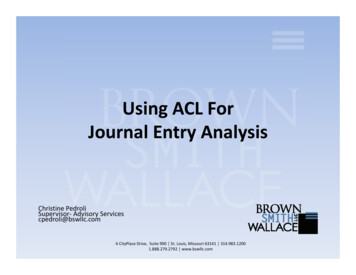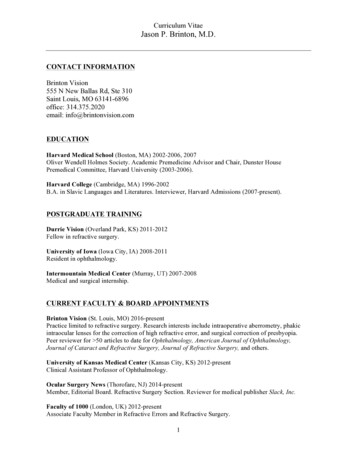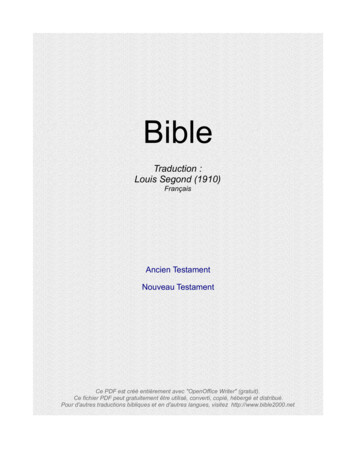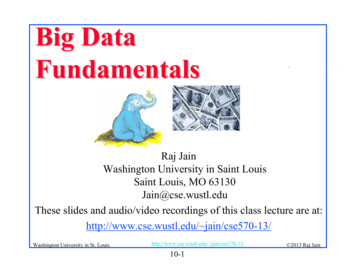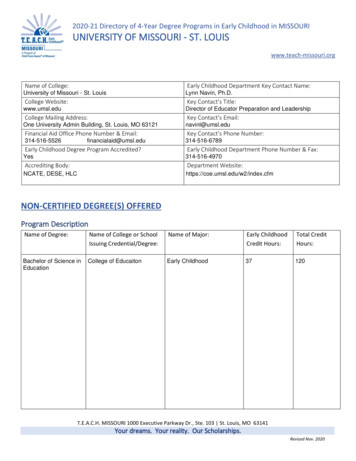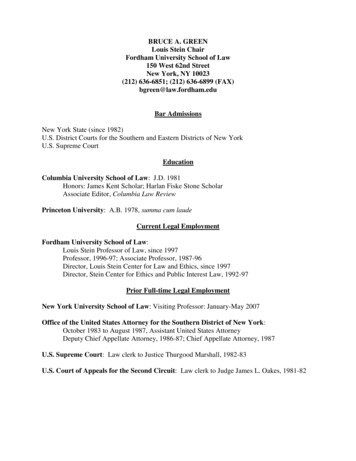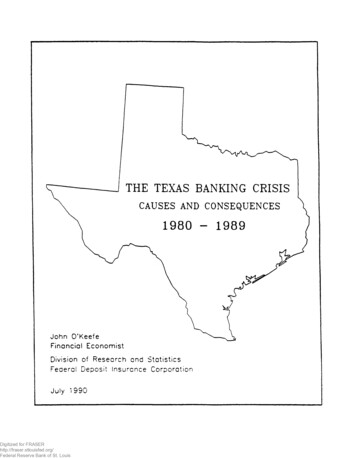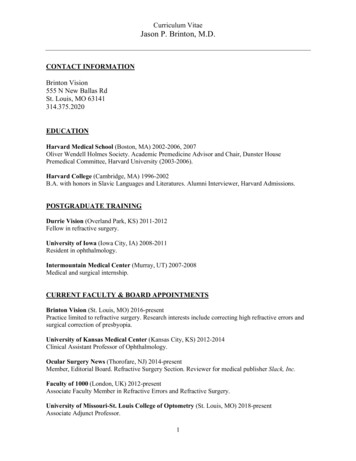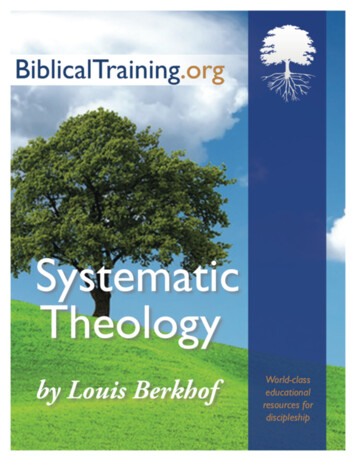
Transcription
Preface .17PART ONE: THE DOCTRINE OF GODTHE BEING OF GODI. The Existence of God.18A. Place of the Doctrine of God in DogmaticsB. Scripture Proof for the Existence of GodC. Denial of the existence of God in its various formsD. The So-called Rational Proofs for the Existence of God.II. The Knowability of God.30A. God Incomprehensible but yet KnowableB. Denial of the Knowability of GodC. Self-revelation the Prerequisite of all Knowledge of GodIII. Relation of the Being and Attributes of God .43A. The Being of GodB. The Possibility of Knowing the Being of GodC. The Being of God Revealed in His AttributesIV. The Names of God.50A. The Names of God in GeneralB. The Old Testament Names and their MeaningC. The New Testament Names and their InterpretationV. The Attributes of God in General .55A. Evaluation of the Terms UsedB. Method of determining the attributes of GodC. Suggested Divisions of the AttributesVI. The Incommunicable Attributes .61A. The Self-Existence of God2
B. The Immutability of GodC. The Infinity of GodD. The Unity of GodVII. The Communicable Attributes .69A. The Spirituality of GodB. Intellectual AttributesC. Moral AttributesD. Attributes of SovereigntyVIII. The Holy Trinity .89A. The Doctrine of the Trinity in HistoryB. God as Trinity in UnityC. The Three Persons Considered SeparatelyTHE WORKS OF GODI. The Divine Decrees in General .108A. The Doctrine of the Decrees in TheologyB. Scriptural Names for the Divine DecreesC. The Nature of the Divine DecreesD. The Characteristics of the Divine DecreeE. Objections to the Doctrine of the DecreesII. Predestination .118A. The Doctrine of Predestination in HistoryB. Scriptural Terms for PredestinationC. The Author and Objects of PredestinationD. The Parts of PredestinationE. Supra- and InfralapsarianismIII. Creation in General .137A. The Doctrine of Creation in History3
B. Scriptural Proof for the Doctrine of CreationC. The Idea of CreationD. Divergent Theories Respecting the Origin of the WorldIV. Creation of the Spiritual World.153A. The Doctrine of the Angels in HistoryB. The Existence of the AngelsC. The Nature of the AngelsD. The Number and Organization of the AngelsE. The Service of the AngelsF. The Evil AngelsV. Creation of the Material World .163A. The Scriptural Account of CreationB. The Hexaemeron, or the Work of the Separate DaysVI. Providence.180A. Providence in GeneralB. PreservationC. ConcurrenceD. GovernmentE. Extraordinary Providences or MiraclesPART TWO:THE DOCTRINE OF MAN IN RELATION TO GODMAN IN HIS ORIGINAL STATEI. The Origin of Man .196A. The Doctrine of Man in Dogmatics.B. Scriptural Account of Origin of Man.C. The Evolutionary Theory of the Origin of Man.D. The Origin of Man and the Unity of the Roce.4
II. The Constitutional Nature of Man .206A. The Constituent Elements of Human Nature.B. The Origin of the Soul in the Individual.III. Man as the Image of God.219A. Historical Views of the Image of God in Man.B. Scriptural Data Respecting the Image of God in Man.C. Man as the Image of God.D. The Original Condition of Man as the Image of God.IV. Man in the Covenant of Works .230A. The Doctrine of the Covenant of Works in History.B. The Scriptural Foundation for the Doctrine of the Covenant of Works.C. Elements of the Covenant of Works.D. The Present Status of the Covenant of Works.MAN IN THE STATE OF SINI. The Origin of Sin .239A. Historical Views Respecting the Origin of Sin.B. Scriptural Data Respecting the Origin of Sin.C. The Nature of the First Sin or the Fall of Man.D. The First Sin or the Fall as Occasioned by Temptation.E. The Evolutionary Explanation of the Origin of Sin.F. The Results of the First Sin.II. The Essential Character of Sin .249A. Philosophic Theories Respecting the Nature of Evil.B. The Scriptural Idea of Sin.C. The Pelagian View of Sin.D. The Roman Catholic View of Sin.III. The Transmission of Sin.2605
A. Historical Review.B. The Universality of Sin.C. The Connection of Adam’s Sin with that of the Race.IV. Sin in the Life of the Human Race .268A. Original Sin.B. Actual Sin.V. The Punishment of Sin .280A. Natural and positive penalties.B. Nature and Purpose of Punishments.C. The actual penalty of sin.MAN IN THE COVENANT OF GRACEI. Name and Concept of the Covenant.288A. The Name.B. The Concept.II. The Covenant of Redemption .292A. Separate Discussion of this Desirable.B. Scriptural Data for the Covenant of Redemption.C. The Son in the Covenant of Redemption.D. Requirements and Promises in the Covenant of Redemption.E. The Relation of this Covenant to the Covenant of Grace.III. Nature of the Covenant of Grace.300A. Comparison of the Covenant of Grace and the Covenant of Works.B. The Contracting Parties.C. The Contents of the Covenant of Grace.D. The Characteristics of the Covenant of Grace.E. The Relation of Christ to the Covenant of Grace.IV. The Dual Aspect of the Covenant.3136
A. An External and an Internal Covenant.B. The Essence and the Administration of the Covenant.C. A Conditional and an Absolute Covenant.D. The Covenant as a Purely Legal Relationship and as a Communion of Life.E. Membership in the Covenant as a Legal Relationship.V. The Different Dispensations of the Covenant .320A. The Proper Conception of the Different Dispensations.B. The Old Testament Dispensation.C. The New Testament Dispensation.PART THREE:THE DOCTRINE OF THE PERSON and THE WORK OFCHRISTTHE PERSON OF CHRISTI. The Doctrine of Christ in History.333A. The Relation between Anthropology and Christology.B. The Doctrine of Christ before the Reformation.C. The Doctrine of Christ after the Reformation.II. The Names and Natures of Christ .342A. The Names of Christ.B. The Natures of Christ.III. The Unipersonality of Christ .352A. Statement of the Church’s View Respecting the Person of Christ.B. Scriptural Proof for the Unipersonality of Christ.C. The Effects of the Union of the Two Natures in One Person.D. The Unipersonality of Christ a Mystery.E. The Lutheran Doctrine of the Communication of Attributes.F. The Kenosis Doctrine in Various Forms.7
G. The Theory of Gradual Incarnation.THE STATES OF CHRISTI. The State of Humiliation .364A. Introductory: The Doctrine of the States of Christ in General.B. The State of Humiliation.II. The State of Exaltation .378A. General Remarks on the State of Exaltation.B. The Stages of the State of Exaltation.THE OFFICES OF CHRISTI. Introduction; The Prophetic Office .391A. Introductory Remarks on the Offices in General.B. The Prophetic Office.II. The Priestly Office.397A. The Scriptural Idea of a Priest.B. The Sacrificial Work of Christ.III. The Cause and Necessity of the Atonement .404A. The Moving Cause of the Atonement.B. Historical Views respecting the Necessity of the Atonement.C. Proofs for the Necessity of the Atonement.D. Objections to the Doctrine of the Absolute Necessity of the Atonement.IV. The Nature of the Atonement.411A. Statement of the Penal Substitutionary Doctrine of the Atonement.B. Objections to the Satisfaction or Penal Substitutionary Doctrine of theAtonement.V. Divergent Theories of the Atonement .424A. Theories of the Early Church.8
B. The Satisfaction Theory of Anselm (Commercial Theory).C. The Moral Influence Theory.D. The Example Theory.E. The Governmental Theory.F. The Mystical Theory.G. The Theory of Vicarious Repentance.VI. The Purpose and the Extent of the Atonement .433A. The Purpose of the Atonement.B. The Extent of the Atonement.VII. The Intercessory Work of Christ .442A. Scriptural Proof for the Intercessory Work of Christ.B. The Nature of Christ’s Intercessory Work.C. The Persons for Whom and the Things for Which He Intercedes.D. The Characteristics of His Intercession.VIII. The Kingly Office .449A. The Spiritual Kingship of Christ.B. The Kingship of Christ over the Universe.PART FOUR:THE DOCTRINE OF THE APPLICATION OF THEWORK OF REDEMPTIONI. Soteriology in General .457A. Connection Between Soteriology and the Preceding Loci.B. The Ordo Salutis, (Order of Salvation).II. The Operations of the Holy Spirit in General.467A. Transition to the Work of the Holy Spirit.B. General and Special Operations of the Holy Spirit.C. The Holy Spirit as the Dispenser of Divine Grace.9
III. Common Grace .477A. Origin of the Doctrine of Common Grace.B. Name and Concept of Common Grace.C. Common Grace and the Atoning Work of Christ.D. The Relation Between Special and Common Grace.E. The Means by Which Common Grace Operates.F. The Fruits of Common Grace.G. Objections to the Reformed Doctrine of Common Grace.IV. The Mystical Union.495A. Nature of the Mystical Union.B. Characteristics of the Mystical Union.C. Erroneous Conceptions of the Mystical Union.D. The Significance of the Mystical Union.V. Calling in General and External Calling .503A. Reasons for Discussing Calling First.B. Calling in General.C. External Calling.VI. Regeneration and Effectual Calling .515A. The Scriptural Terms for Regeneration and Their Implications.B. The Use of the Term “Regeneration” in Theology.C. The Essential Nature of Regeneration.D. Effectual Calling in Relation to External Calling and Regeneration.E. The Necessity of Regeneration.F. The Efficient Cause of Regeneration.G. The Use of the Word of God as an Instrument in Regeneration.H. Divergent Views of Regeneration.VII. Conversion .532A. The Scriptural Terms for Conversion.10
B. The Biblical Idea of Conversion. Definition.C. The Characteristics of Conversion.D. The Different Elements in Conversion.E. The Psychology of Conversion.F. The Author of Conversion.G. The Necessity of Conversion.H. Relation of Conversion to other Stages of the Saving Process.VIII. Faith .547A. Scriptural Terms for Faith.B. Figurative Expressions Used to Describe the Activity of Faith.C. The Doctrine of Faith in History.D. The Idea of Faith in Scripture.E. Faith in General.F. Faith in the Religious Sense and Particularly Saving Faith.G. Faith and Assurance.H. The Roman Catholic Conception of Faith.IX. Justification.567A. The Scriptural Terms for Justification and Their Meaning.B. The Doctrine of Justification in History.C. The Nature and Characteristics of JustificationD. The Elements of Justification.E. The Sphere in which Justification Occurs.F. The Time of Justification.G. The Ground of Justification.H. Objections to the Doctrine of Justification.I. Divergent Views of Justification.X. Sanctification .586A. The Scriptural Terms for Sanctification and Holiness.B. The Doctrine of Sanctification in History.11
C. The Biblical Idea of Holiness and Sanctification.D. The Nature of Sanctification.E. The Characteristics of Sanctification.F. The Author and Means of Sanctification.G. Relation of Sanctification to Other Stages in the Ordo Salutis.H. The Imperfect Character of Sanctification in This Life.I. Sanctification and Good Works.XI. Perseverance of the Saints .606A. The Doctrine of the Perseverance of the Saints in History.B. Statement of the Doctrine of Perseverance.C. Proof for the Doctrine of Perseverance.D. Objections to the Doctrine of Perseverance.E. The Denial of this Doctrine Makes Salvation Dependent on Man’s Will.PART FIVE:THE DOCTRINE OF THE CHURCH AND OF THEMEANS OF GRACETHE CHURCHI. Scriptural Names of the Church and the Doctrine of theChurch in History .614A. Scriptural Names for the Church.B. The Doctrine of the Church in History.II. Nature of the Church .
A. An External and an Internal Covenant. B. The Essence and the Administration of the Covenant. C. A Conditional and an Absolute Covenant. D. The Covenant as a Purely Legal Relationship and as a Communion of Life.

